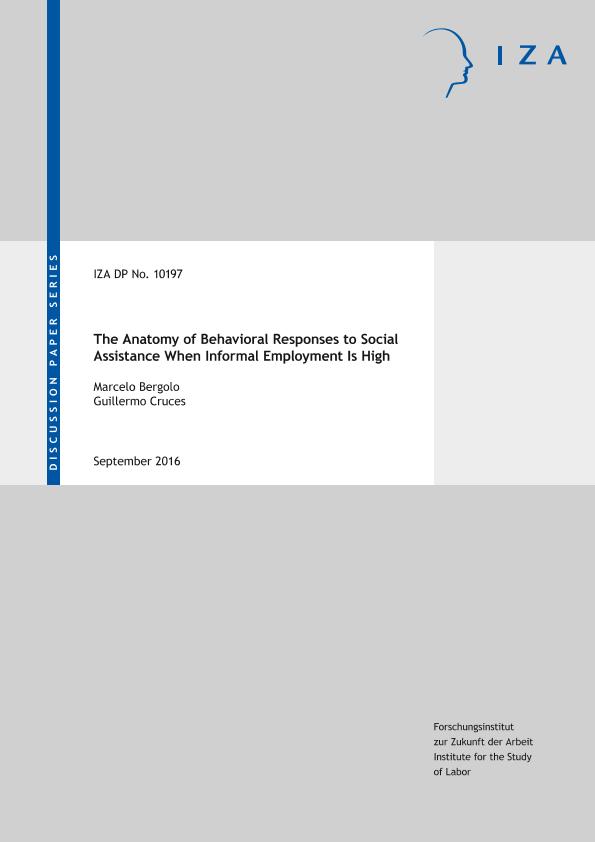Mostrar el registro sencillo del ítem
dc.contributor.author
Bergolo Sosa, Marcelo Luis

dc.contributor.author
Cruces, Guillermo Antonio

dc.date.available
2020-03-30T17:44:10Z
dc.date.issued
2016-09
dc.identifier.citation
Bergolo Sosa, Marcelo Luis; Cruces, Guillermo Antonio; The anatomy of behavioral responses to social assistance when informal employment is high; IZA - Institute of Labor Economics; IZA Working Papers; 10197; 9-2016; 1-86
dc.identifier.issn
2365-9793
dc.identifier.uri
http://hdl.handle.net/11336/101379
dc.description.abstract
The disincentive effects of social assistance programs on registered employment are a first order policy concern in developing countries. Means tests determine eligibility with respect to some income threshold, and governments can only verify earnings from registered employment. The loss of benefit at some level of formal earnings is an implicit tax that results in a strong disincentive for formal employment. We study an income-tested program in Uruguay and extend previous literature by developing an anatomy of the behavioral responses to this program. Our identification strategy is based on a sharp discontinuity in the program?s eligibility rule and uses information from the program?s records, social security administration data, and a follow-up survey. First, we establish that beneficiaries respond to the program?s incentives by reducing their levels of registered employment by about 8 percentage points. Second, we find the program induces a larger reduction of formal employment for individuals with a medium probability to be a registered employee, suggesting some form of segmentation ? those with a low propensity to work formally do not respond to the financial incentives of the program. Third, we find evidence that the fall in registered employment is due to a larger extent to an increase in unregistered employment, and to a lesser extent to a shift towards non employment. Fourth, we find an elasticity of participation in registered employment of about 1.7, implying a deadweight loss from the behavioral responses to the program of about 3.2% of total registered labor income.
dc.format
application/pdf
dc.language.iso
eng
dc.publisher
IZA - Institute of Labor Economics
dc.rights
info:eu-repo/semantics/openAccess
dc.rights.uri
https://creativecommons.org/licenses/by-nc-sa/2.5/ar/
dc.subject
welfare policy
dc.subject
labor supply
dc.subject
registered employment
dc.subject
labor informality
dc.subject.classification
Economía, Econometría

dc.subject.classification
Economía y Negocios

dc.subject.classification
CIENCIAS SOCIALES

dc.title
The anatomy of behavioral responses to social assistance when informal employment is high
dc.type
info:eu-repo/semantics/article
dc.type
info:ar-repo/semantics/artículo
dc.type
info:eu-repo/semantics/publishedVersion
dc.date.updated
2019-09-27T14:28:51Z
dc.journal.number
10197
dc.journal.pagination
1-86
dc.journal.pais
Alemania

dc.journal.ciudad
Bonn
dc.description.fil
Fil: Bergolo Sosa, Marcelo Luis. Universidad Nacional de La Plata. Facultad de Ciencias Económicas. Departamento de Ciencias Económicas. Centro de Estudios Distributivos Laborales y Sociales; Argentina
dc.description.fil
Fil: Cruces, Guillermo Antonio. Universidad Nacional de La Plata. Facultad de Ciencias Económicas. Departamento de Ciencias Económicas. Centro de Estudios Distributivos Laborales y Sociales; Argentina
dc.journal.title
IZA Working Papers
dc.relation.alternativeid
info:eu-repo/semantics/altIdentifier/url/https://www.iza.org/publications/dp/10197/the-anatomy-of-behavioral-responses-to-social-assistance-when-informal-employment-is-high
Archivos asociados
